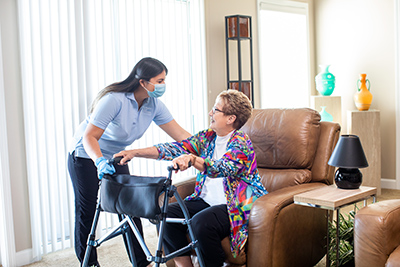Walkers for Seniors: A Better Way to Look at This Independence Device
Using Tools for Mobility Has Great Health Benefits
Acknowledging and accepting that you need the assistance that a walker provides isn't always easy. Many people buy walkers with seats, and then put the box off to the side for weeks (or longer) until they're emotionally ready just to unpack it. It helps to change your thinking about a walker from a sign of getting older or of a disability to a tool that allows you to maintain independence and a sense of security. A walker can make the difference between sitting at home being sedentary (a risk factor for heart disease and many other illnesses) and getting out and engaging in favorite activities.
Be Sure to Get the Walker That Meets Your Needs
 Of course, buying a walker isn't the same as buying a new sweater. Here are some topics to consider.
Of course, buying a walker isn't the same as buying a new sweater. Here are some topics to consider.
Talk to Your Doctor or a Physical Therapist.
Your doctor should be able to recommend one—about matching a walker to your needs. Just the fear of falling isn't necessarily a reason to use a walker, though it can help lessen the risk of falling if you're unsteady on your feet. Poor balance or problems with your gait could be helped with a walker. Be sure you really need one.
Look at Different Designs.
Basic walkers are available with four straight legs and rubber feet that you lift to move. For smooth movement without lifting, most can be outfitted or bought with rear glides and front wheels or wheels on all four legs, usually called a rollator. Some rollator styles have a three-wheel triangular design for easier maneuverability indoors. The model best for you depends on your gripping ability, your upper and lower body strength and your weight, among other factors. Wheels make the device move more smoothly, but require that you can control the walker so that it doesn't run ahead of you. Having an expert opinion will help you make the right choice.
Look for a Walker with Adjustable Features, Especially its Height.
That way you can adjust it properly. The top of the walker should line up with your wrists when your arms are at your sides. This will help you avoid lurching to one side or hunching over the walker as you walk. As you move, your arms should be slightly bent, with your elbows at a comfortable angle, but you shouldn't have to bend forward at the waist to reach it. The width of the walker can be adjusted on some models so that you're comfortable standing with your feet between the back legs, the ideal positioning—your feet shouldn't be at the front bar.
There have been reports of seniors falling when improperly handling a walker for elderly use, particularly people over age 85 and very often at home. To prevent this, the Centers for Disease Control and Prevention suggests walker safety strategies such as working with a professional on how best to use your walker and adjust it to your height. Besides traditional office visits, look for learning opportunities like health fairs.
Learn To Use Walkers To Your Advantage
Knowing the right way to walk with a walker is your best first step. Though not a substitute for professional instruction, keep these guidelines in mind:
- Stay upright as you walk to protect your back—no hunching.
- Hold the walker still as you step into it with one leg, taking care not to step too close to the front of the device. At the same time, avoid pushing the walker too far in front of you.
- Place your other leg inside the walker.
- Move the walker forward and then repeat this procedure, stepping in one leg at a time.
- Turn with care: Use small steps and take your time.
You should regularly check your walker for wear. Many parts are replaceable, including rubber foot caps, wheels and glides. When buying new wheels in particular, note the wheel width before ordering and check to see if you need a specific brand or can use a universal design.



